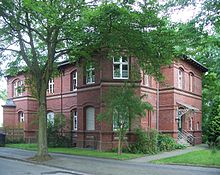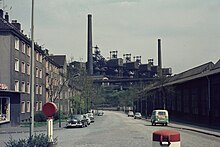Stahlhausen
Stahlhausen is a district of Bochum . Together with Goldhamme, it forms the Hamme district , which is part of the Mitte district to the west of the city center .
history
The Alleestraße was completed as a road from Bochum to Essen-Steele as early as 1794 . Here in 1842 Jacob Mayer and Eduard Kühne founded the Mayer cast steel factory , from which the Bochum Association developed. The group built the first workers' houses in 1858. In 1868 the construction of an architecturally homogeneous workers' settlement began in the open field. In 1874 a total of 400 apartments were finally available on eight parallel streets. They orientated themselves on the Mülhauser type . The settlement was surrounded by hedges. Only a few years later, Bochum's inner city was expanded to the west, for example the Christ Church was built .
Moltkemarkt , today Springerplatz , formed the core of the new district . On Baarestrasse there was a large, company-owned dormitory for single workers, the Kosthaus , built in 1873/1874 . During the time of National Socialism , the Kosthaus was also the seat of an SA guard room, in which political opponents were held captive and mistreated. During the Second World War, steel production became important to the war effort. Several thousand forced laborers were employed. At the beginning of 1945 there were 7,500 people. A branch of the Buchenwald concentration camp was located on Brüllstrasse (see Brüllstrasse concentration camp external command ). Because of the aerial warfare, some production was moved to underground halls. An air raid shelter was built at Springerplatz in which part of the civilian population could find shelter. After the war, most of the buildings were destroyed. Stahlhauser Strasse and Gremmestrasse still give an impression of the original construction .
The structural change led to industrial wastelands developing. To the north, on the site of the former blast furnaces, is now the West Park , which is intended to be used for recreation and business. Greatest interest is here Centennial Hall . In the south is the President business park . The Bochumer Ring runs to the west . The Heusnerviertel on the street of the same name, which was dominated by squatters for a short time , was cleared with major police actions and demolished for the construction of the motorway. Located adjacent to the work area of the north Alleestraße is the Bochum red light district consisting of the Gußstahlstraße and branching off from their dead-end in the angle .
Monument protection
On November 29, 2011, the Bochum City Council decided on the statutes for historic monuments for Stahlhausen, which came into force on January 20, 2012. This makes Stahlhausen the city 's second protected monument area alongside the city park district. The aim of the divisional statutes is to preserve a testimony to the history of the people in the Ruhr area by maintaining the layout of the settlement, the existing buildings and the open spaces.
Web links
Individual evidence
- ↑ E. Führ, D. Stemmrich: The thingness of social configurations. In: Klaus Bergmann, Rolf Schörken (eds.): History in everyday life - everyday life in history , Düsseldorf 1982.
- ↑ City of Bochum: Stahlhausen monument area statutes . (PDF; 48 kB)
Coordinates: 51 ° 29 ′ N , 7 ° 12 ′ E





